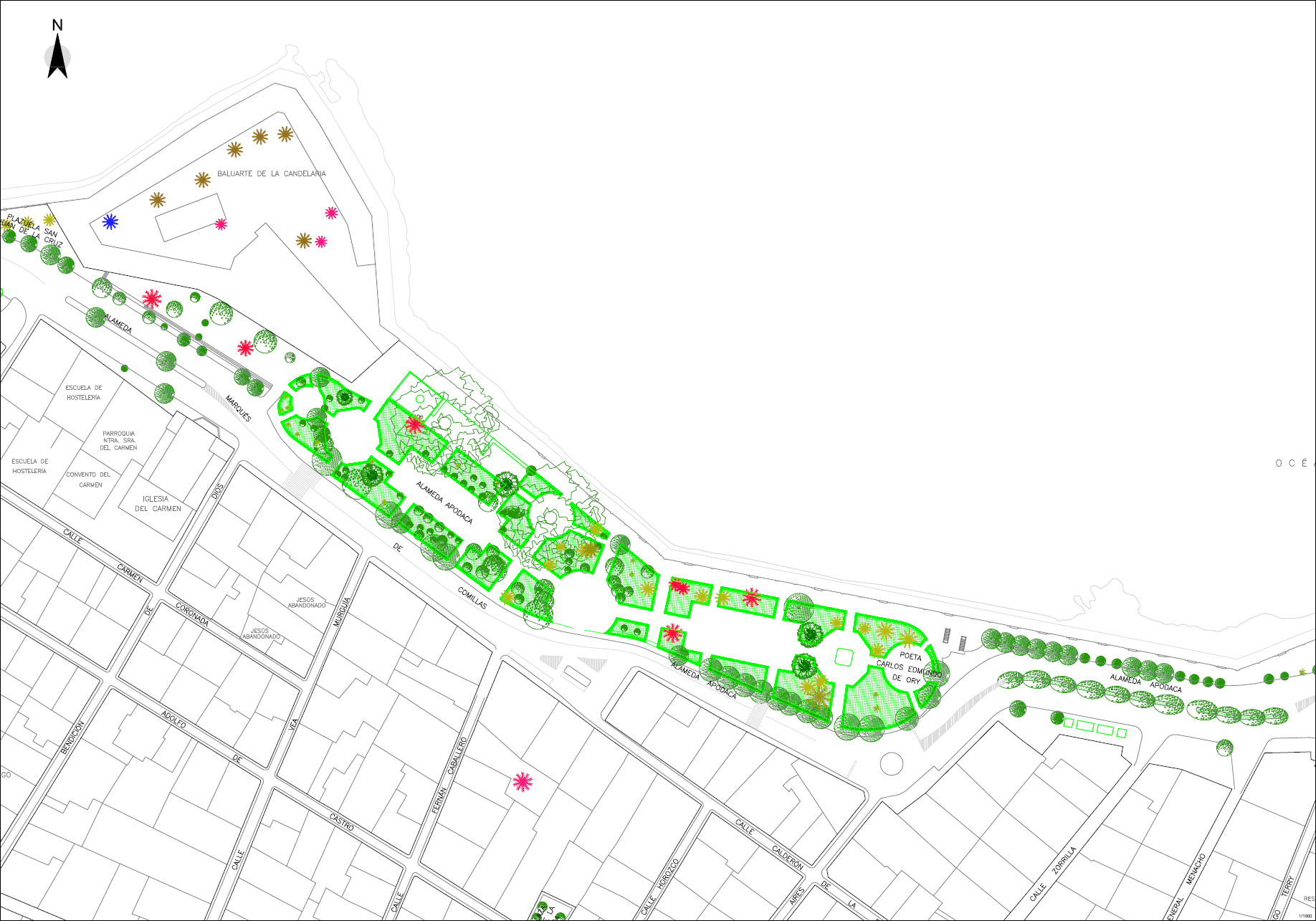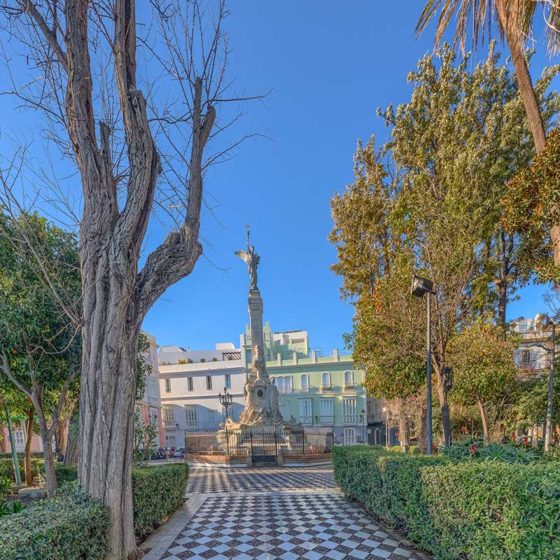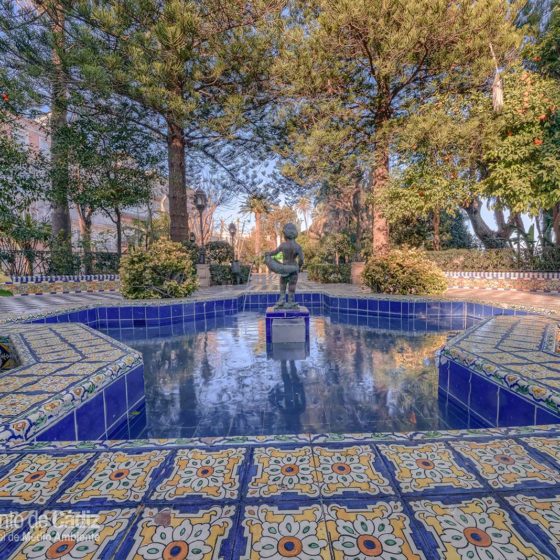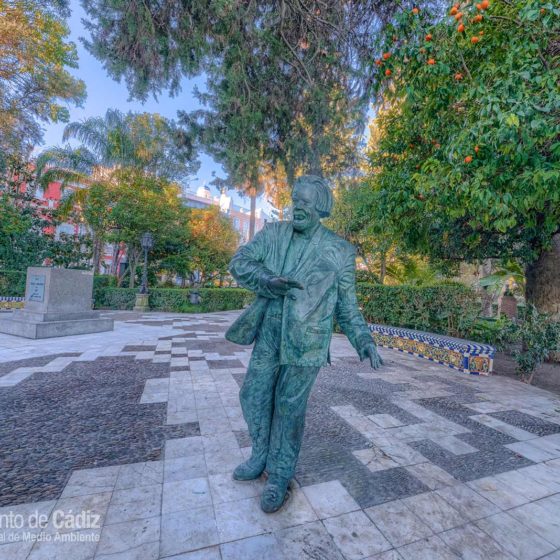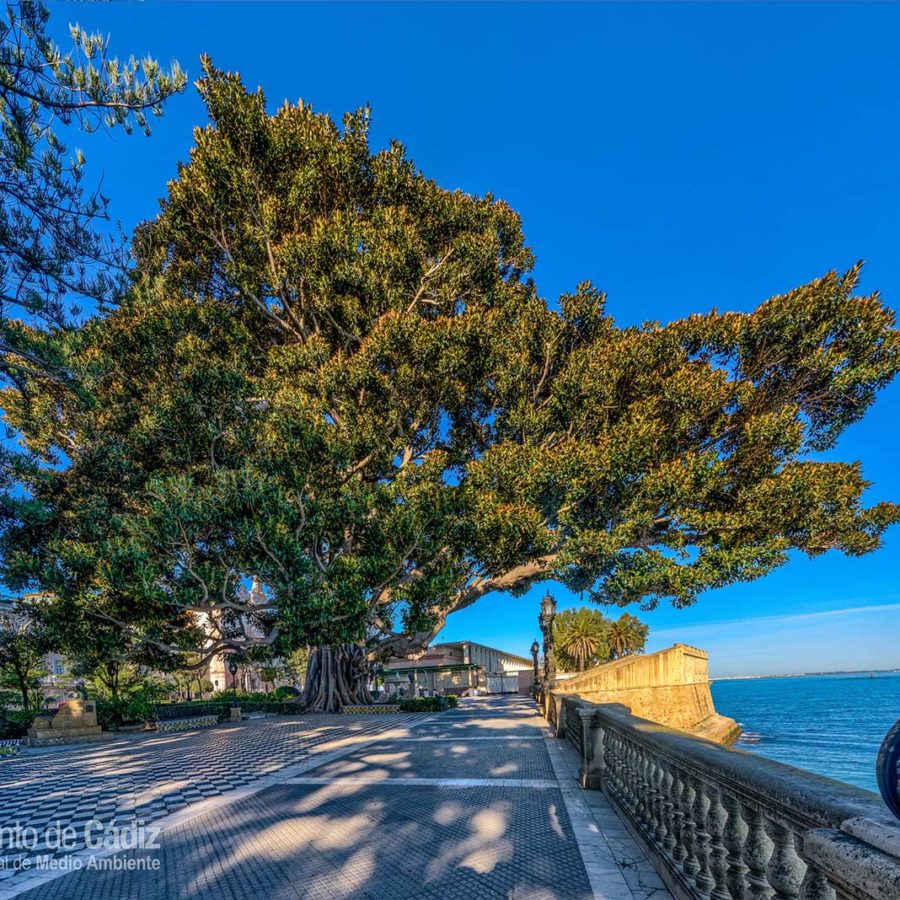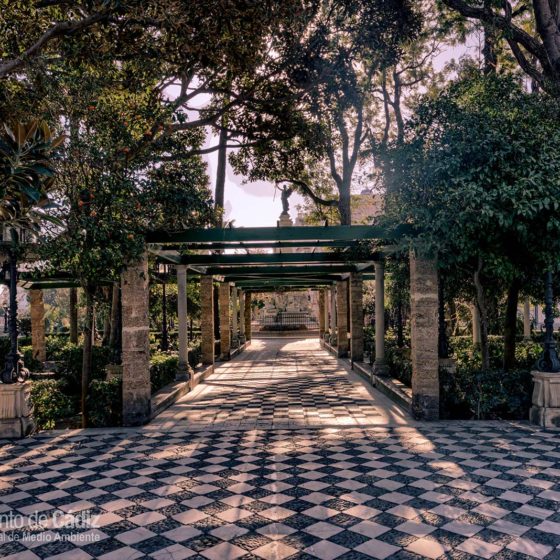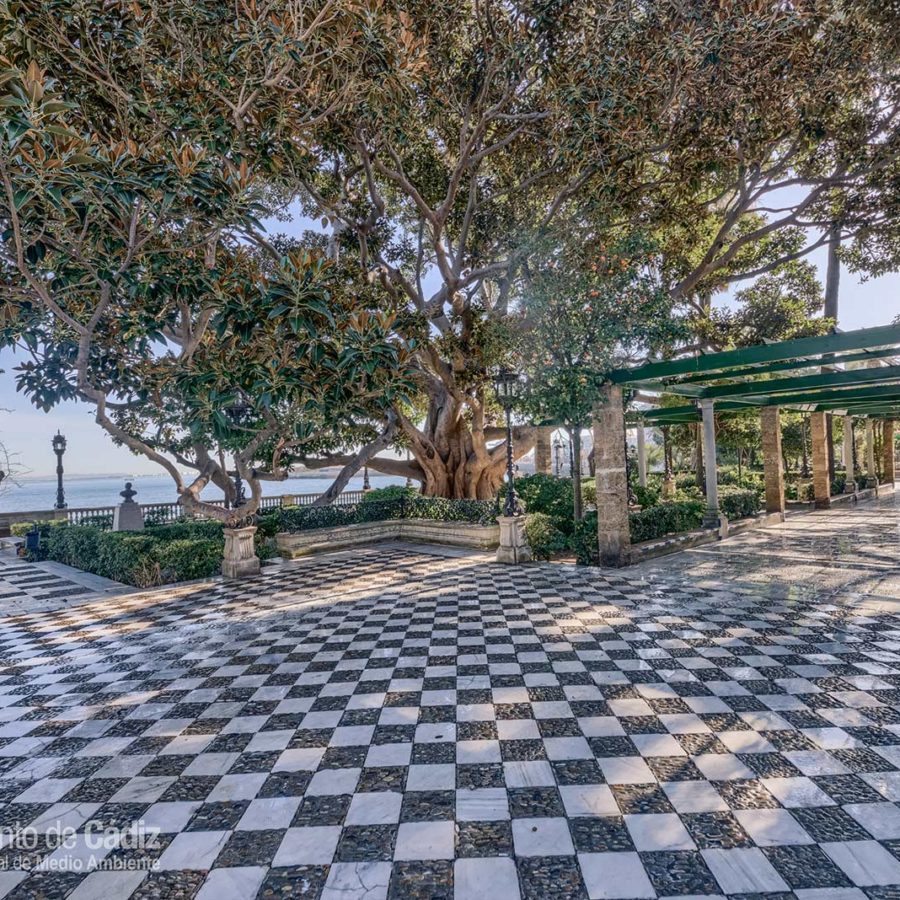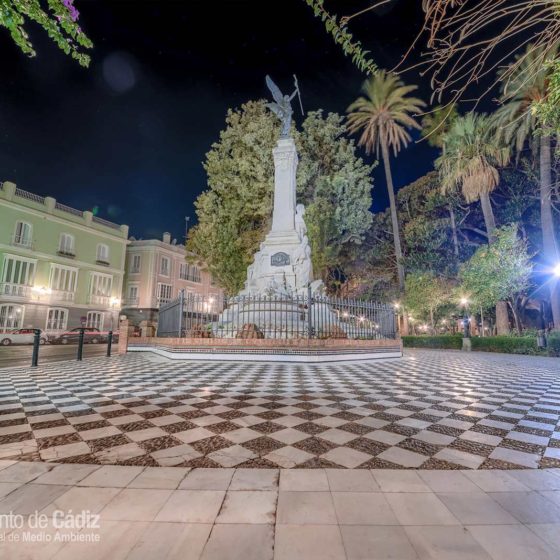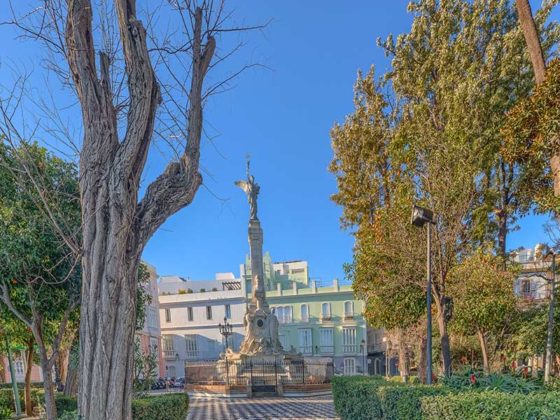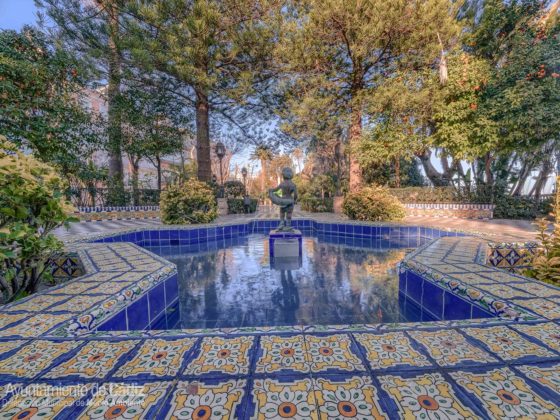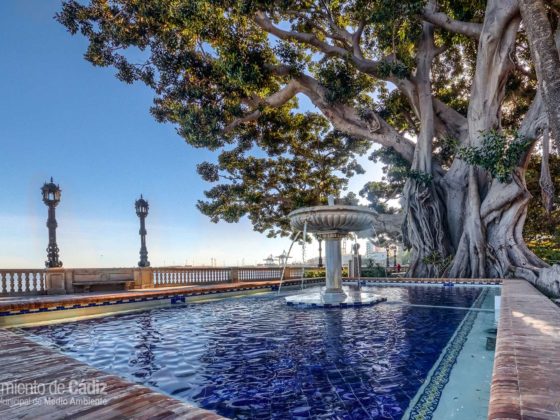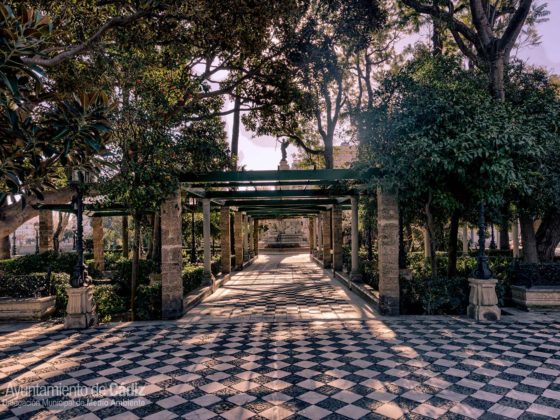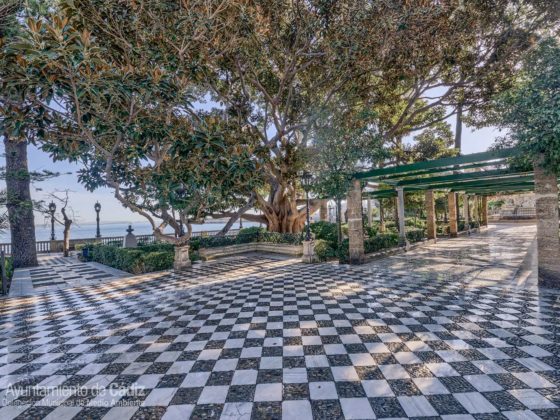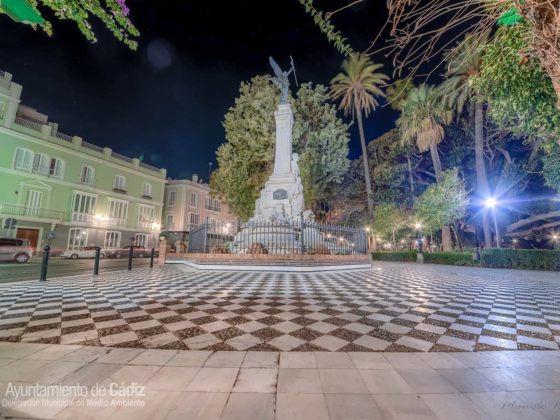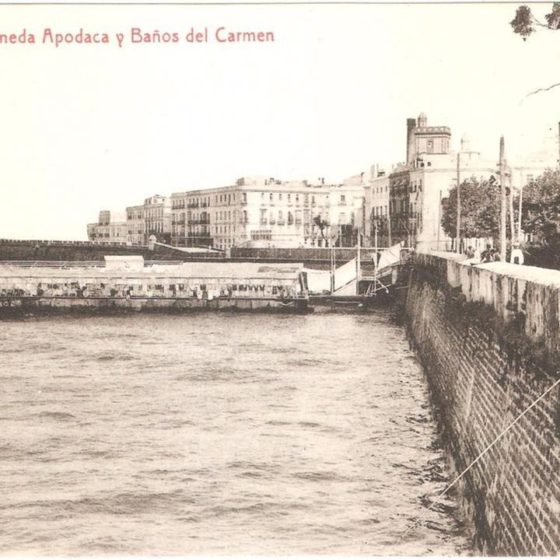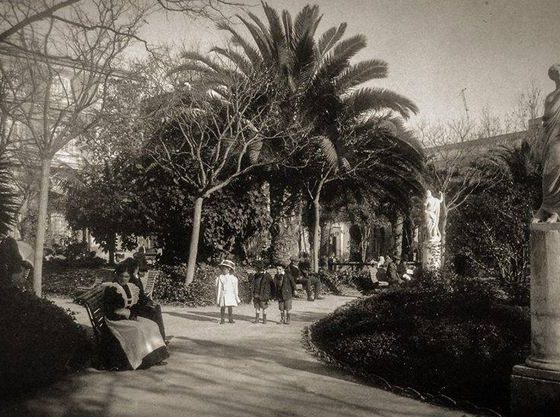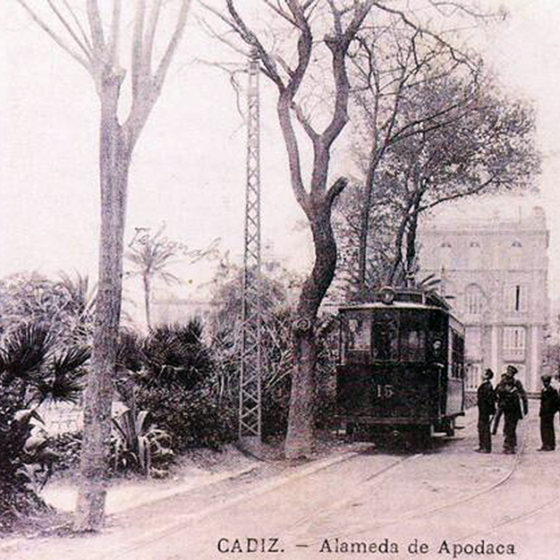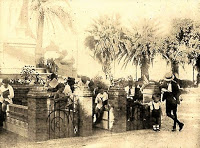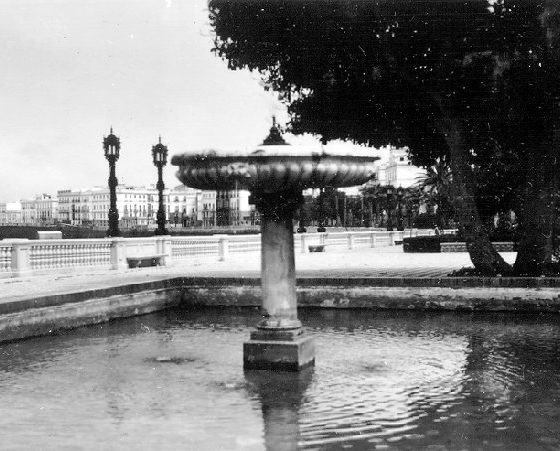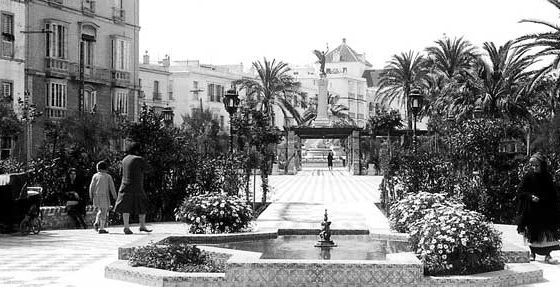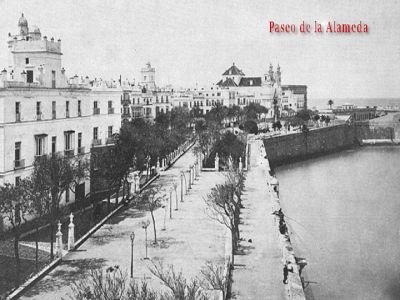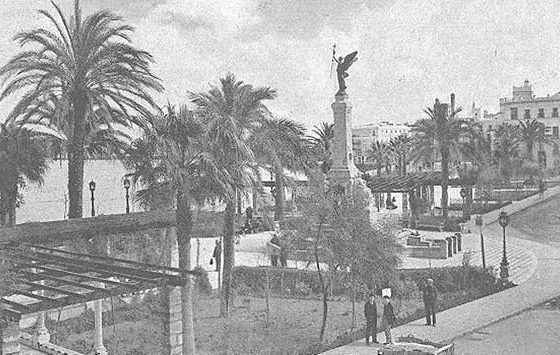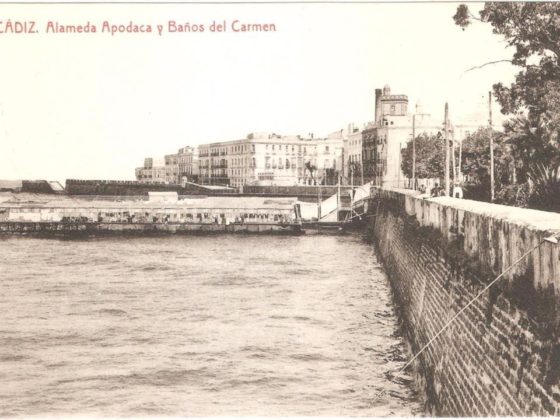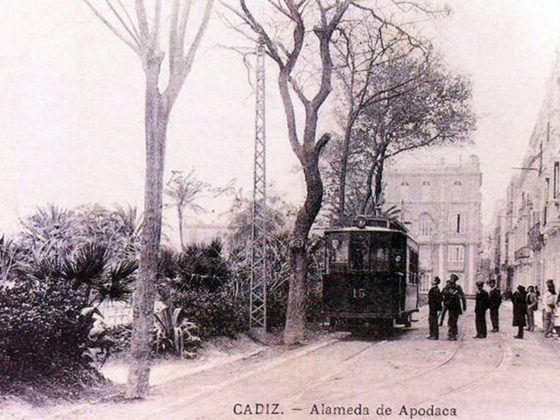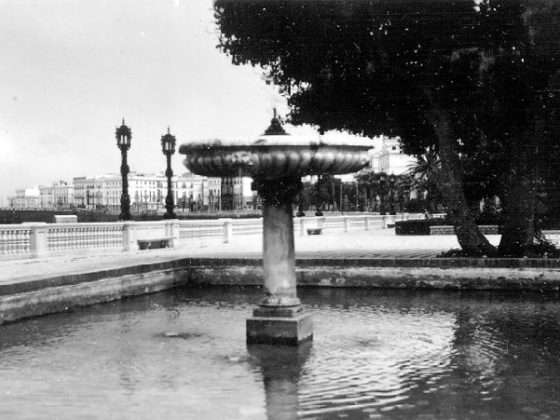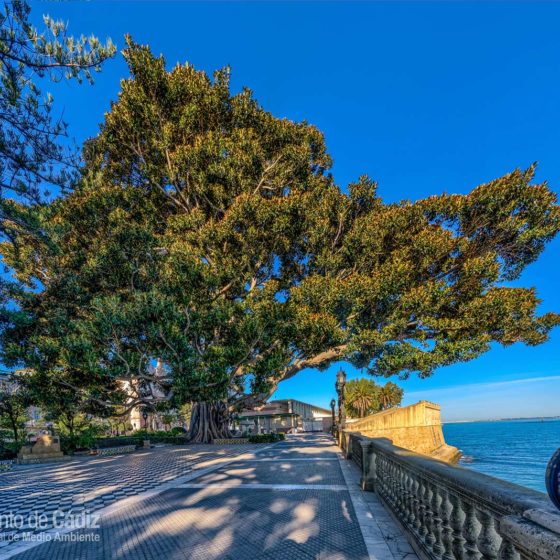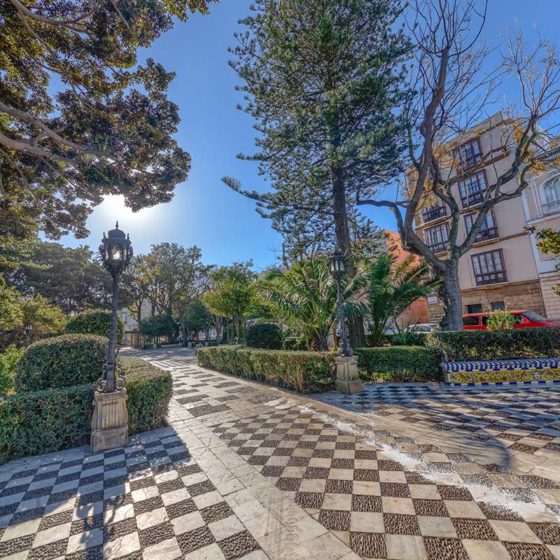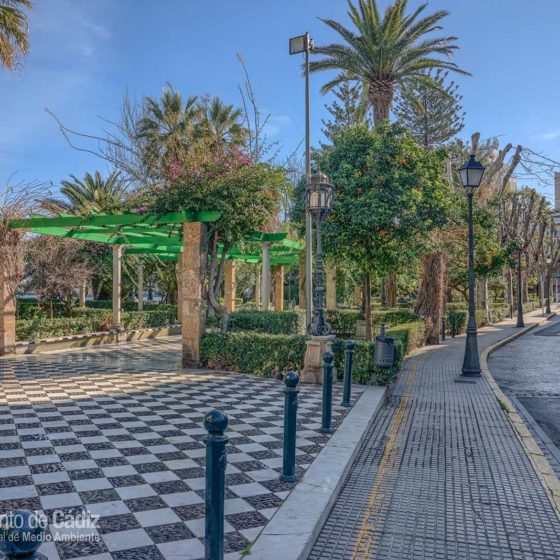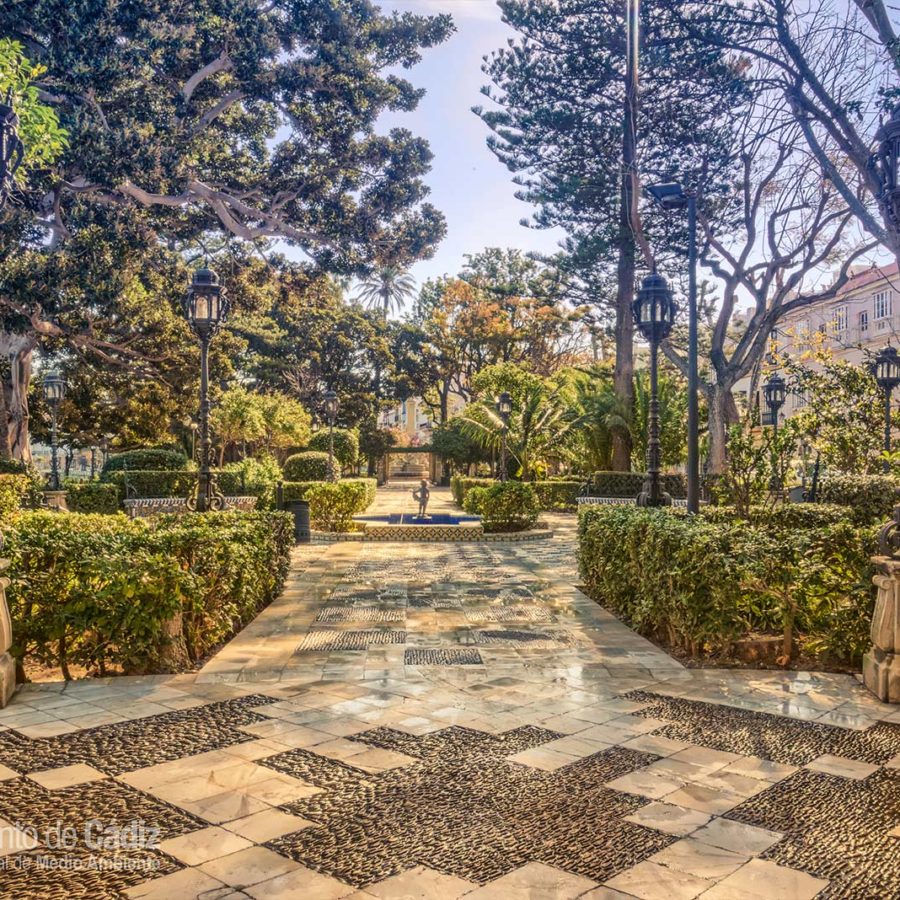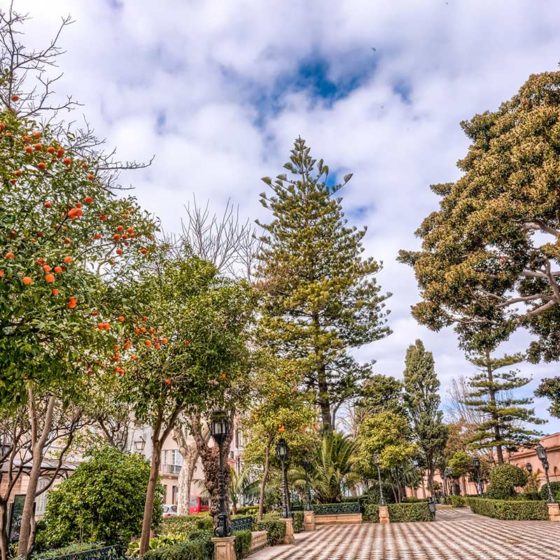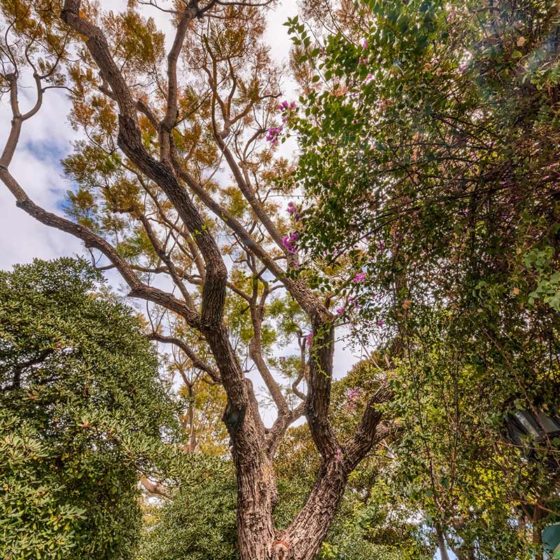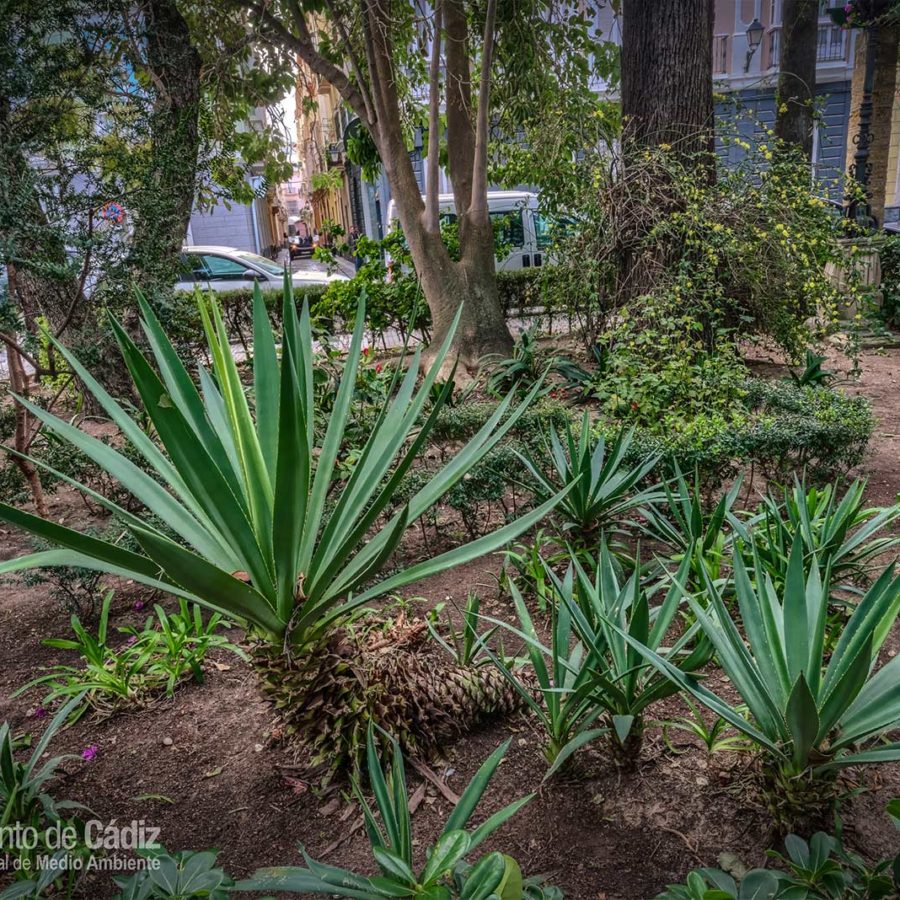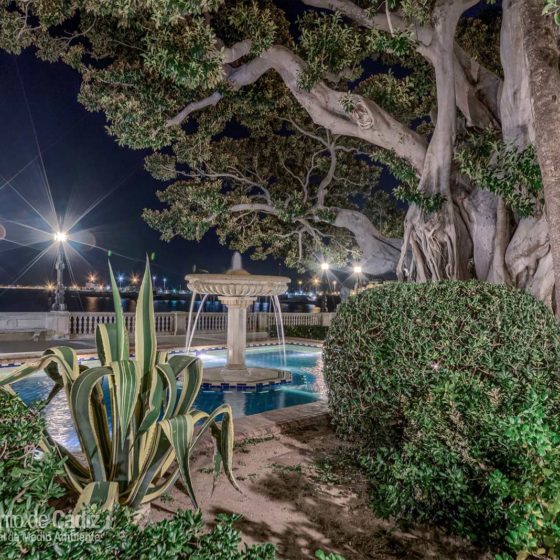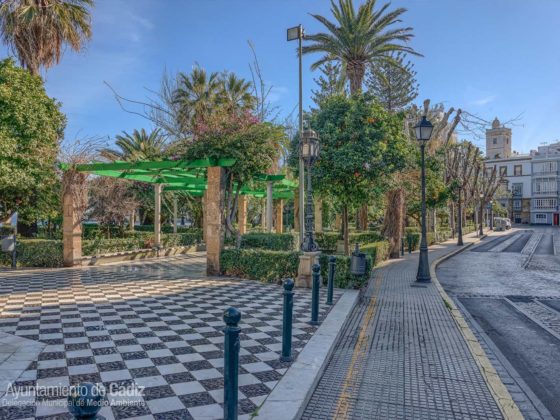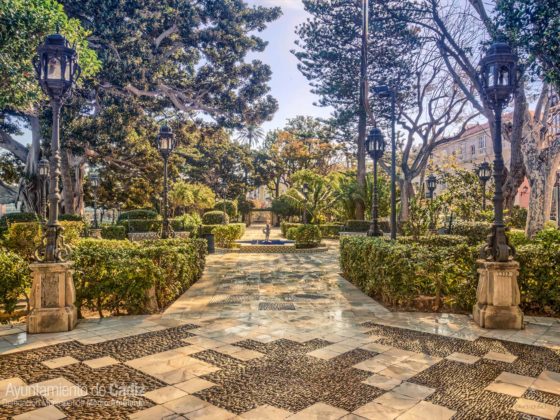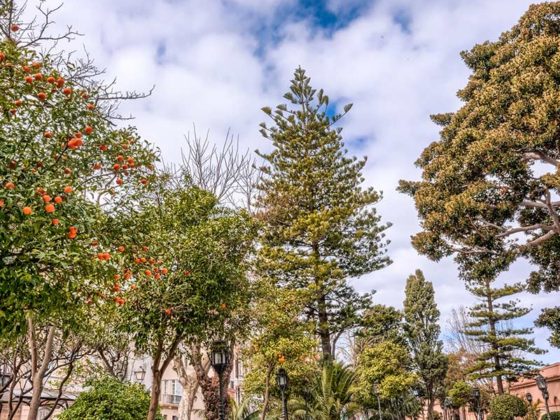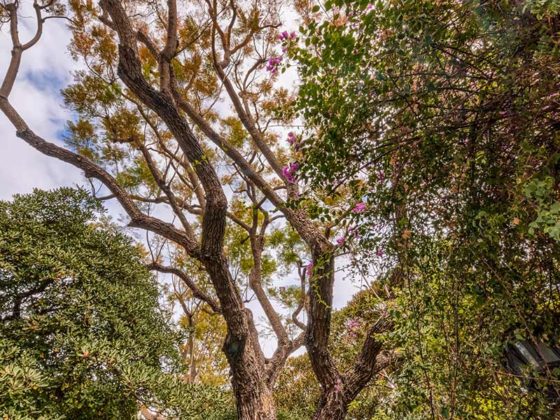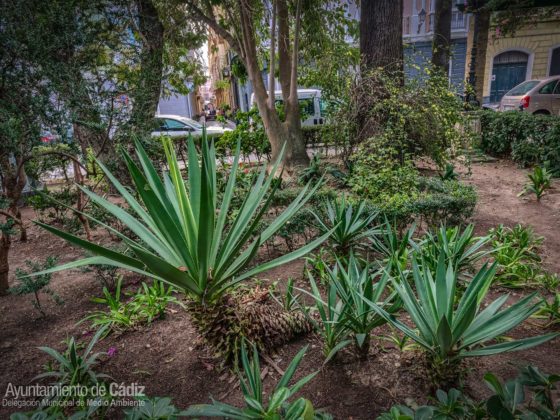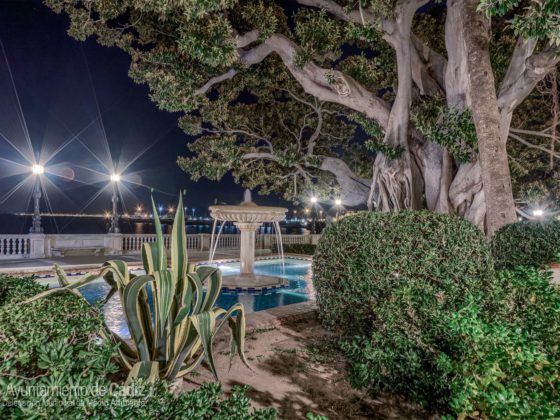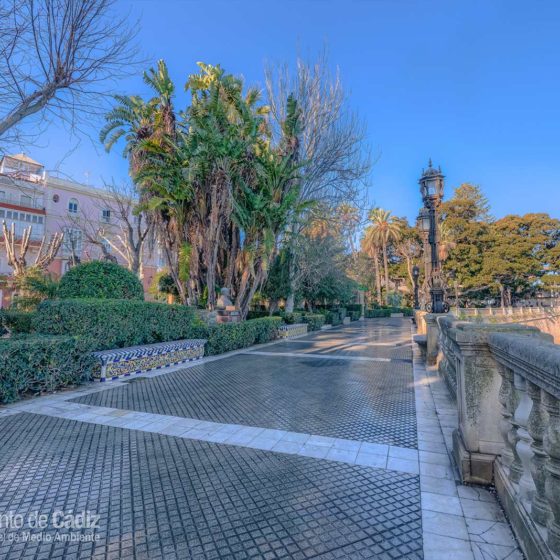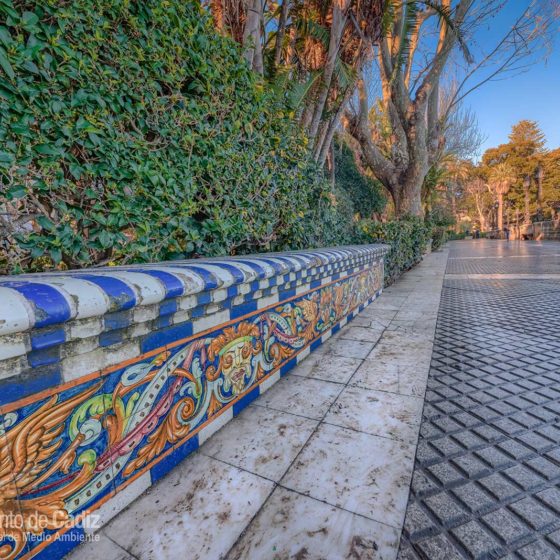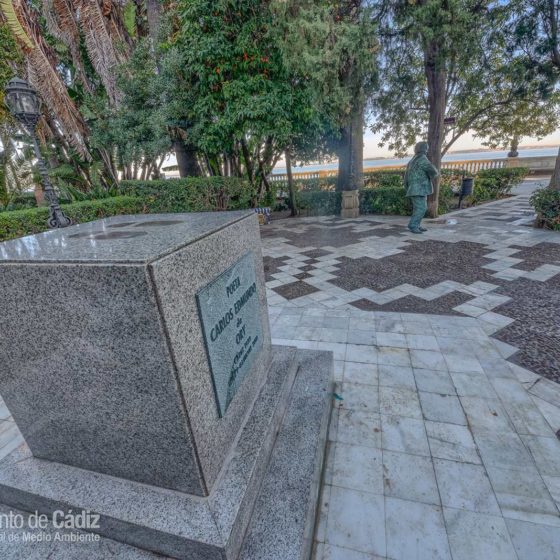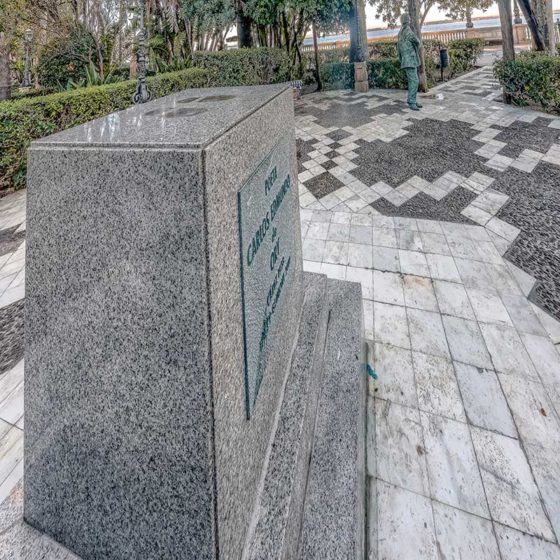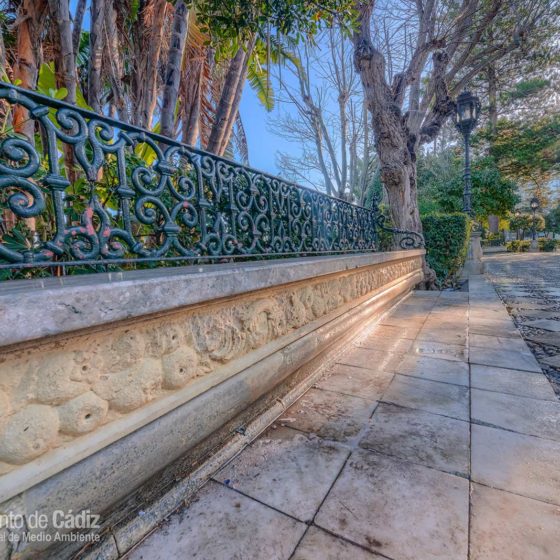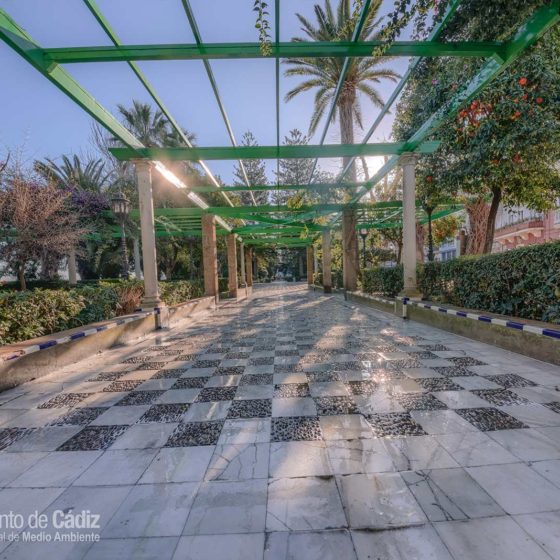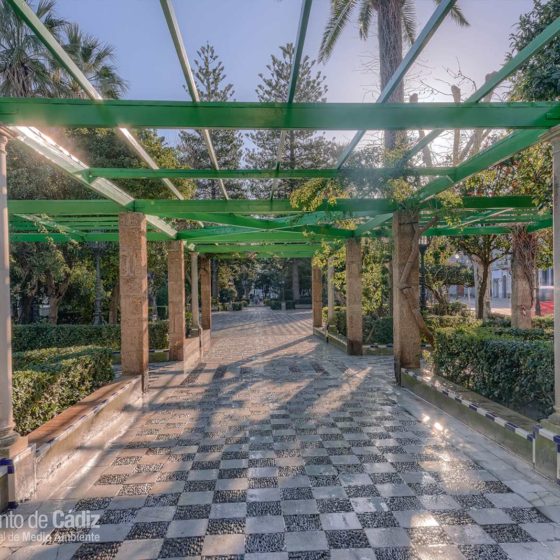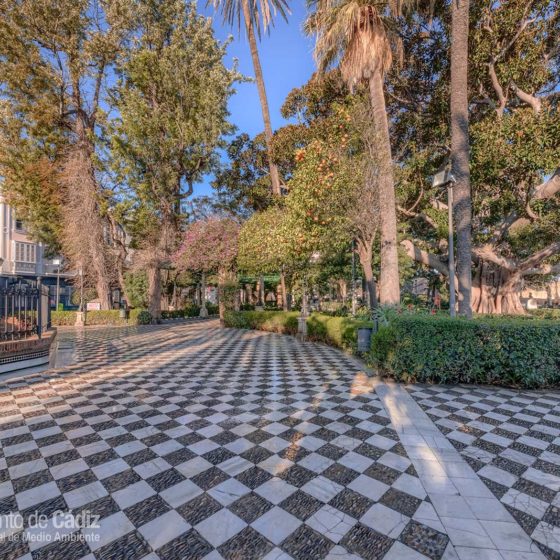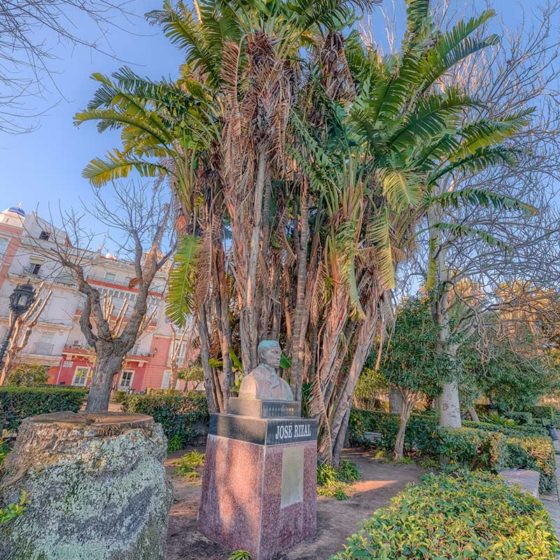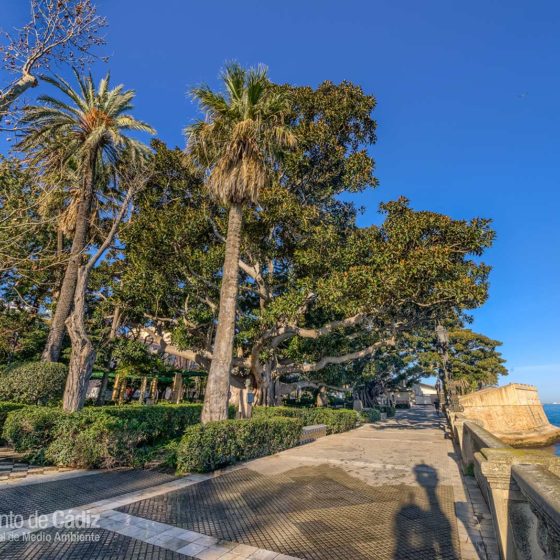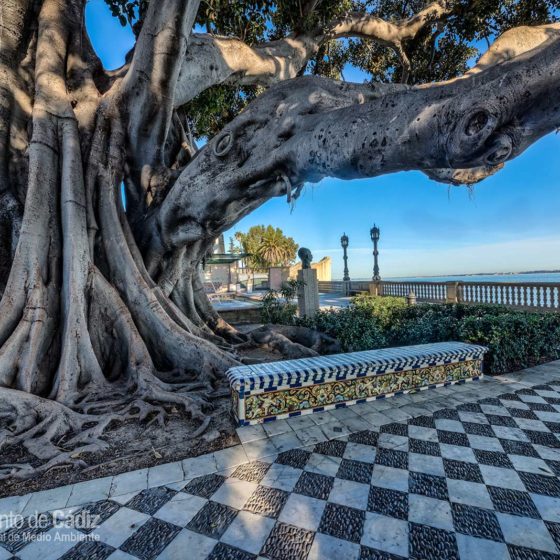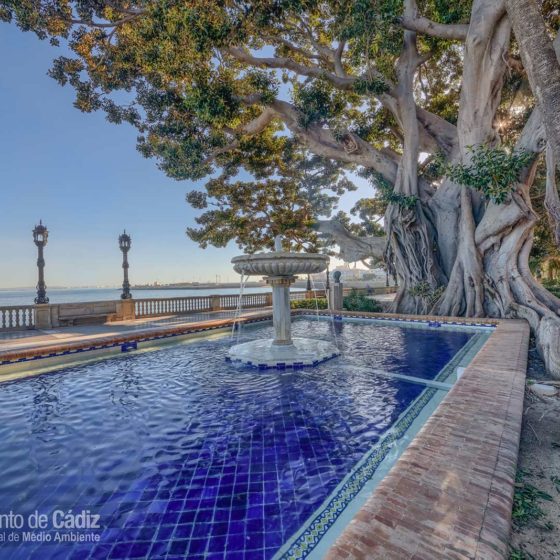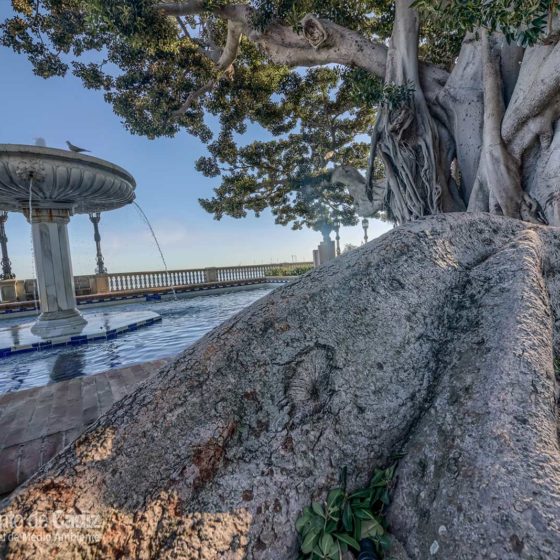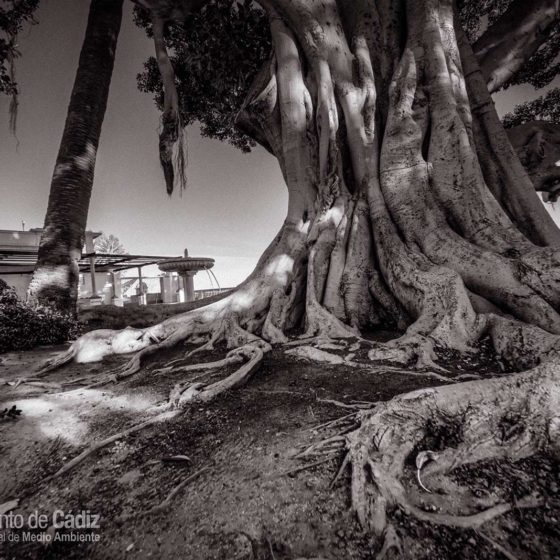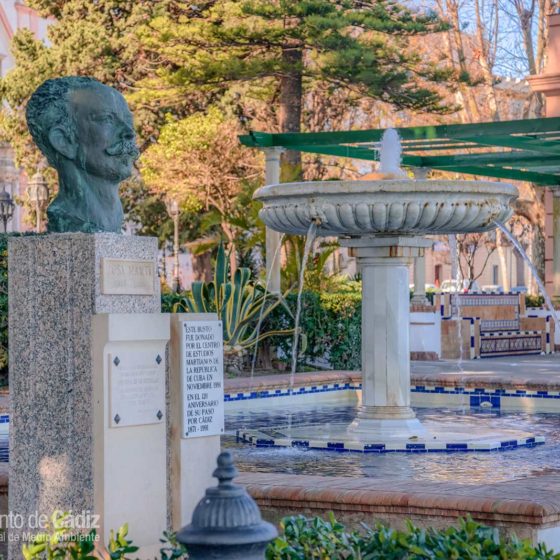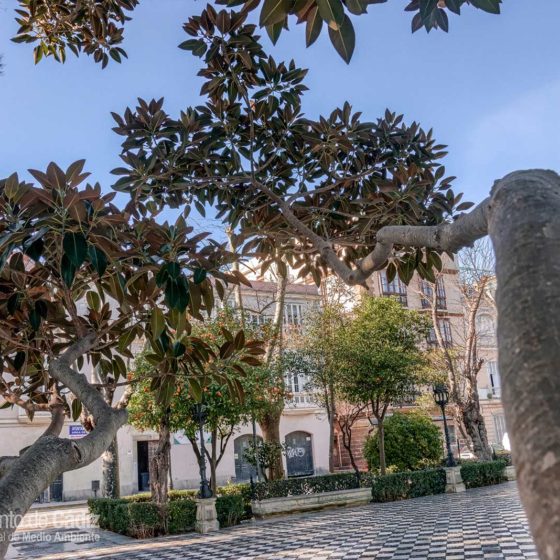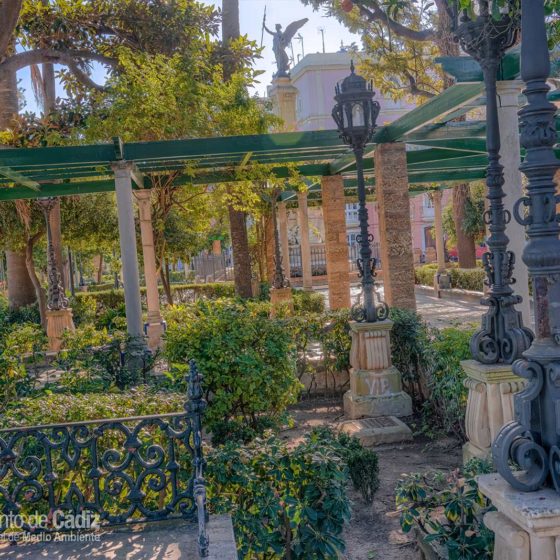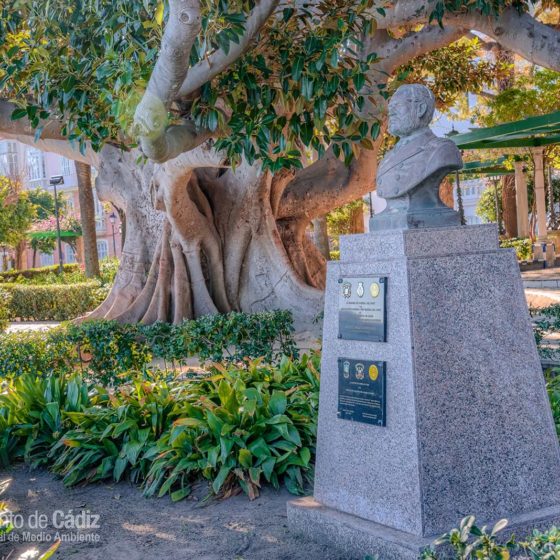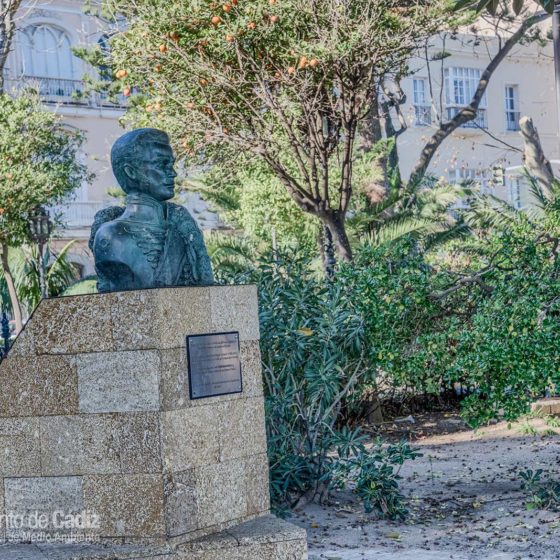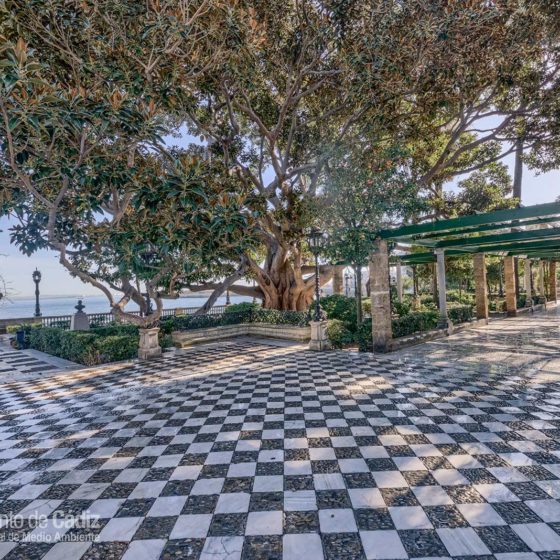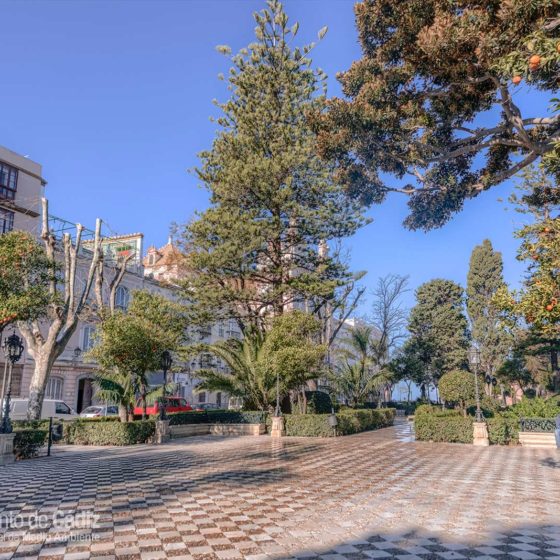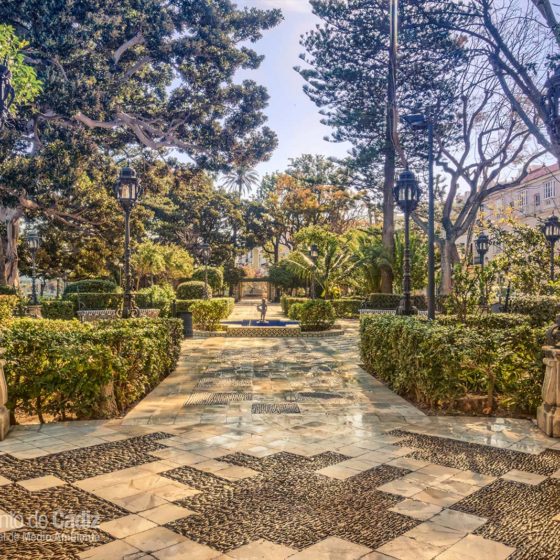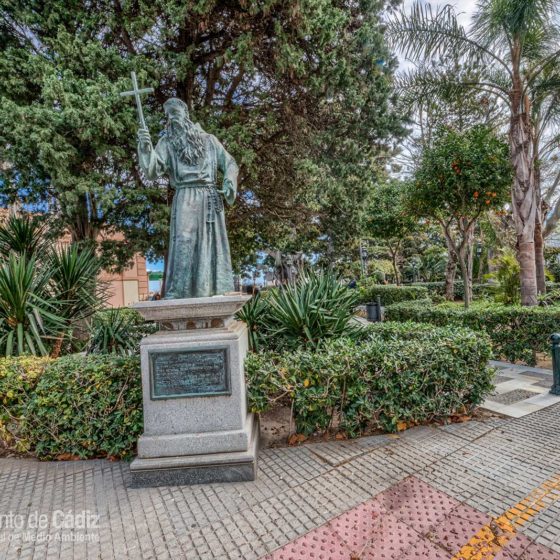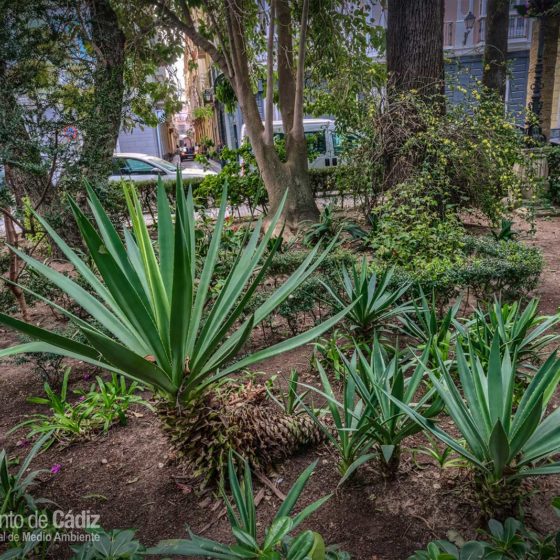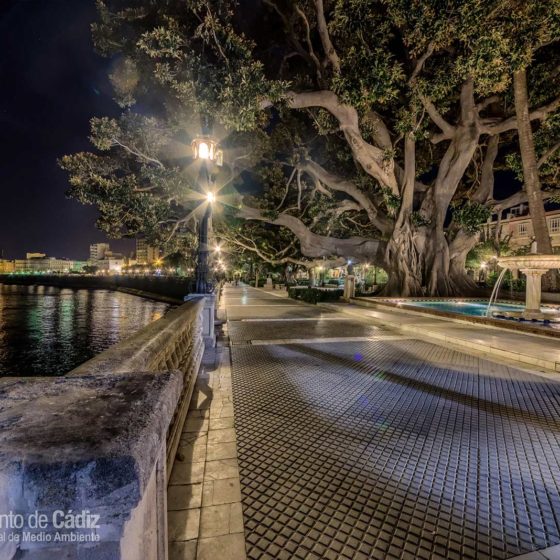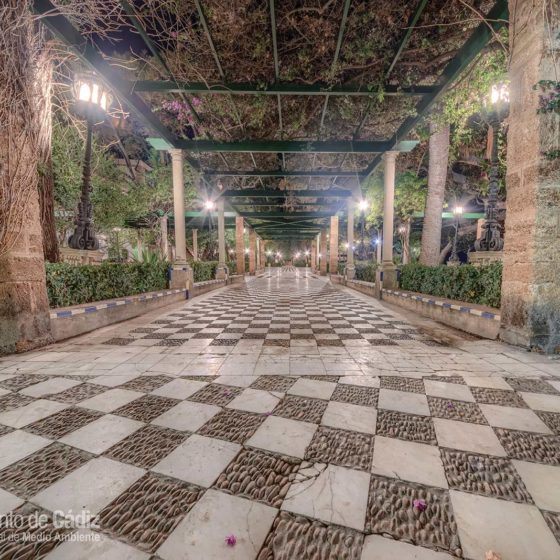It preserves its image of a Botanical Garden from the 19th century Romantic era
The Alameda Clara Campoamor and Hermanas Carvia Bernal together, is an Elizabethan style landscape with a railing that overlooks the sea, which is one of the best walks in the City of Cadiz.
The Junta of Andalucia declared it an Asset of Cultural Interest (BOJA 19/3/2004) and is included in the General Catalogue of the Historical Heritage of Andalusia.
The Alameda
History
Featured species
The Alameda
The Alameda Clara Campoamor and Hermanas Carvia Bernal together, is an Elizabethan, romantic-style landscaped area with a railing that overlooks the sea. It is renowned for its great beauty in one of the best walks in the city of Cadiz.
The Junta of Andalucia declared it an Asset of Cultural Interest (BOJA 19/3/2004) and is included in the General Catalogue of the Historical Heritage of Andalusia. It preserves its image of a Botanical Garden from the 19th century Romantic era
It is a walk through gardens, which surrounds the south of the old centre with a view from east to west. From this walk you can see the Bay of Cadiz and you can see neighbouring cities of the bay such as El Puerto de Santa Maria and Rota.
The Alameda Clara Campoamor is located between two significant constructions: the Baluarte de la Candelaria, in front of the Iglesia del Carmen (Carmen Church), which formed part of the sea front of the bay that protected the entrance to the port. Also, the walls of San Carlos, towards Calle Fermín Salvochea and Ustáriz (Fermín Salvochea and Ustáriz street). These walls were built in the late eighteenth century and its purpose was to act as a defence of the northwest front of the city.
The east side of the promenade received its current name Alameda Apodaca in 1856, in honour of Admiral Juan José Ruiz de Apodaca and Eliza, while the west side is called Marqués de Comillas, in honour of Claudio López Bru, the second Marques de Comillas.
The design includes a slightly broken linear layout on its floor, marked by the Regionalism style, prevailing at the beginning of the 20th century, embodied by the architect Juan Talavera. He used Sevillian-glazed ceramics and the forging of iron in benches and lampposts, as characteristic features. The fountains stand out for their beauty, both on the side of the Baluarte next to the huge Ficus, and on the inside of the garden, as they are built with pottery from Triana.
The space is made up of a series of flowerbeds in different layouts, which border small squares. These small squares are distributed with a certain symmetry with respect to what could be considered the centre of the space, a little square occupied by a great monument to the Marques of Comillas, founder of the Transatlantic Company, under which a library existed for a time.
From this small square, there are separate paths covered with pergolas to the right and left, leading to wide rectangular squares, from which, in turn, a corridor leads to other octagonal ones. Finally, on the border of the Alameda, the squares have an oval shape.
One of the interesting things that this space has is the popular sentry boxes that hang from the balustrade, called escaragüaitas. In reality, the sentry boxes are located on the ground and not above ground, as they are in the Alameda.
The leafy vegetation constitutes one of the essential characteristics of the Alameda.
The adjoining area between the promenade and the avenue has been planted with deciduous trees, mainly shady trees, while the area near the sea are the most striking species, among which are:
Two magnificent Ficus macrophylla trees, originating from Australia and planted in the early twentieth century, two Indian Laurel trees, of about 75 years of age, two 35-year-old Dragon trees, two Ombú trees which are more than 40 years old and a Chinese palm which is 80 years old.
In the central part we can see several large araucaria trees and groups of Californian palm, date and Mexican palm trees of close to 100 years old.
The flowerbeds are bordered with hedges of different species, such as Thuja, Pittosporum, Ligustrum or Mousehole trees
One of the roundabouts that make up the garden is called “Glorieta Carlos Edmundo de Ory”, in honour of the poet born in Cadiz. There, we can find a sculpture of the writer, as well as a pedestal with his name located in the centre of it.
At the western end of the park, we can find a fountain composed mainly of brightly coloured polychrome tiles. The two octagonal squares that exist in the Alameda are adorned by two low-rise fountains with geometric shapes and tiles.
The Alameda Clara Campoamor also contains a large number of bust sculptures in honour of different influential people, mainly Latin Americans, who began to settle in the 80s.
So, we can find one dedicated to the Nicaraguan poet Rubén Darío, one of the Grand Admiral of Peru and national hero, Don Miguel Grau Seminario and the Cuban politician and poet, the creator of the Revolutionary Party and organiser of the War of 95 against the Spanish colonial army, José Martí. There are also statues dedicated to the Dominican politician and liberator Juan Pablo Duarte, to the Chilean general José Miguel Carrera, to the distinguished Puerto Rican sailor and Deputy of the Cortes of Cadiz of 1812, Ramón Power and Giralt, to the political and military Juan Pablo Duarte, considered one of the Founding Fathers from the Dominican Republic, to José Rizal, a Filipino national hero and finally to Francisco Prieto, a Cadiz-born painter.
History
The Alameda has its origins in a 17th century plantation of poplar trees and vines on the grounds of the old Caletilla de Rota, linked to the sources of the Campo de la Jara. The first walk, wider than the current one, was created in 1617. Between 1750 and 1754 a walkway was built consisting of three streets, divided by rows of trees.
During the eighteenth century and especially since 1788, it experienced improvements that made the place the favourite ride of the bourgeoisie during the summer months, for its freshness.
In the middle of the 19th century, already in Elizabethan times, the promenade was converted into a garden, in keeping with the trend at the time, with marble staircases and seats, iron gates, and circular roundabouts that constituted viewpoints to the sea. The project was carried out by the architects Manuel Bayo and Juan de la Vega. The Alameda was then divided into two zones that retained the width of the main street of the old Alameda running through them. Thus, it was constituted by:
- One area, surrounded by marble seats with iron backs and two rows of trees that shaped the three streets of the promenade. Then there were two gardens, with covers made of stone pillars and between these gardens was a central street facing the promenade. The pavement was composed of sand.
- The next area, known as the “Salón Alto” or “Salón de Cristina”, named in reference to the Queen, in the form of a parallelogram, was divided into four outward-looking semicircles that were converted into viewpoints towards the Bay of Cadiz. This room had four very small gardens placed between the semicircles.
In 1843, the Salon de Cristina was renovated again, with four entrances and statues on pedestals, with a design similar to the Alamedas in Seville and Malaga.
At the end of the 19th century, between 1893 and 1895, the Alameda was again renovated, with a more scenic English design, which got rid of the existing fences and an aviary was installed next to the wall.
In 1927, the regional style architect Juan Talavera y Heredia, who also acted on the Murillo Gardens in Seville, permanently remodelled the gardens, giving it its current Sevillian-style garden appearance, following the canons put in by the Ibero-American Exhibition of Seville in 1927, with fountains, lampposts, wrought iron furniture and Triana ceramics.
On 17th June 1856, this garden received its current name, “Alameda de Apodaca”, in memory of Sir Juan Ruiz de Apodaca and Eliza, an admiral of the army that got the concession of the free port to Cadiz. Without a doubt, the merits of this Cadiz-born man are many. Born in 1754, in the street that today is Fermín Salvochea, at just 13 years old, he enters the Academy of Marine Guards, embarking the San Lorenzo ship, and took part in a battle against the Algerians. After occupying numerous locations and sending several ships, Apodaca was named general commander of the ship, taking charge of the rescue and repair of the ships that survived the combat of Trafalgar.
In 1807 he took command of the squadron and the following year, at the beginning of the Independence War, he made the French fleet that was in Cadiz surrender, under the orders of Admiral Rosilly. He was then promoted to lieutenant general, was named ambassador in London and later Captain General of Cuba.
In January of 1816 he was named Viceroy of New Spain, the territory raised in arms against Spain. Apodaca managed to dominate the revolution by defeating the troops of the rebel Mina in a Mexican property named Venadito.
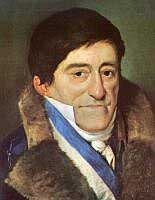 |
|---|
| Juan José Ruiz de Apodaca and Eliza. Portrait of the Naval Museum of Madrid |
In reward for his victory, the King granted him the title of Count of Venadito. Upon his return from America, Ruiz de Apodaca was named Viceroy of Navarre and, later, Captain General of the Navy. He intervened decisively in the efforts to get Puerto Franco to be part of the municipality of Cadiz.
The Count of Venadito died in Madrid on 11th January, 1835. Isabel II issued a Royal Decree ordering that the Navy always has a ship named Conde del Venadito.
Almost twenty years after his death, when the gardens located on the wall were improved in the middle of the 19th century, Cadiz City Council decided to give the east part of the promenade and the gardens located on the wall, the name of the popular admiral. Years later, the homage to Apodaca is completed with a tombstone on the door of his house.
Among the sculptural elements that the walk has, it is worth highlighting that in one of its zones stands the monument of the Marques of Comillas.
This work of great theatricality is the work of the Barcelona sculptor Antonio Parera y Saurina, who is also responsible for the monuments of the Siege of Gerona, in Gerona and of the Venezuelan Independence leader, Mariscal Sucre. Everything would begin with a request from the population and after an intense period of collecting money from the population, where citizens and a large group of Cadiz personalities of the time would participate, the monument would be inaugurated on 12th October, known as Hispanic Day or Día de la Hispanidad, in 1922.
Sir Claudio López, Marqués de Comillas, was a shipowner closely related to the maritime life of the city and was also the owner of Transatlántica, the most important shipping company our country has had in its history.
The latter is precisely what unites the Marques of Comillas with our city. He was a unique character, businessman, blessed and great philanthropist, and although he was not from Cadiz, his whole life was closely linked to the city of Cadiz. Here, he carried out most of his maritime business since the port of Cadiz was the most important in Spain during the late nineteenth and early twentieth centuries. All shipping related to The Americas, the origin of Marques of Comillas family´s fortune, spent long periods of time in a cosmopolitan, varied, rule-breaking but pioneer city: Cadiz
Both he and his family were the promoters of the Matagorda factory. In gratitude for the fact that he had put the entire fleet of his Transatlantic Company at the service of Spain during the wars of the time, the name of a street in the City was dedicated to the family.
The first pensions for orphans, widows and accidents at work, the basis of our current Social Security system, were given to their companies thanks to their generosity towards others.
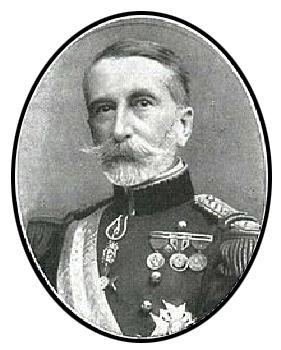 |
|---|
| Claudio López Bru. II Marques of Comillas. |
This monument, carved in bluish stone from Murcia, is placed on a wide base of dark marble from Figueres, Catalonia, from which you can imagine a sailing ship, highlighting the sides of the stern and bow, both of which being symmetrical. On the front, in its flat part, a lion embraces the condor bird, symbolising the union between Spain and America.
En el mismo sitio y con idéntico significado, hay un grupo antropomórfico formado por dos hermosas mujeres, una con el gorro frigio que simboliza la libertad y otra con los atributos de la realeza. Debajo de las estatuas, cincelada en la propia piedra, se lee la frase que refleja el objeto de tal monumento:
TRIBUTE TO THE NEVERENDING BOND OF THE HISPANOAMERICAN UNION
También destacan los distintos medallones y escudos en bronce donde podemos ver a Cervantes incluido en el monumento por ser “el hombre que más contribuyó, con su palabra, a la formación de la raza iberoamericana“; Cristóbal Colón “la persona que unió ambos continente por ser la persona que la “descubrió” oficialmente”.
Also the different bronze medallions and shields stand out where we can see Cervantes included in the monument for being “the man who most contributed, with his word, to the formation of the Ibero-American race“; Christopher Columbus “the person who united both continents for being the person who officially “discovered” these lands.
On the sides, we find two reliefs representing the steam from Cantabria, the first private steam ship that made the journey between Cadiz and America, and on the other side a relief of the Marigalante ship, which was the ship in which Columbus made his second trip to America and that departed from the port of Cadiz in 1493.
In the upper part are the 4 shields representing Cadiz, Spain, the house of the Marques de Comillas, the Hispano-American Academy, as well as the bust of Claudio López Brú, the second Marques of Comillas, carved in Carrara marble, with an inscription that says:
TO THE HONOURABLE SIR DON. CLAUDIO LOPEZ BRU, MARQUES DE COMILLAS. 1922
Finally, the work is crowned with a winged and majestic representation of the Genius of Christianity, a female figure with various symbolic and cultural details that holds, in one hand a cross with an olive branch, the symbol of peace and Christianity, while in the other hand she holds the tablets with the ten commandments of Moses. All this religious symbolism is due to the character and beliefs of the Second Marques de Comillas, a deeply Catholic person.
Underneath the entire sculptural complex, a small crypt was built that housed a small public library, which could be accessed by a small descending staircase, dedicated to marine themes, Hispanic American books and other books provided by the Transatlantic Company as well as by the City Council of Cadiz and the Hispano-American Academy, which currently remains closed.
The mission of this library was not only that the people of Cadiz admire the monument, but that they could read outdoors and learn about marine issues and the relationship between Spain and Latin America.
According to the various chronicles, the library wasn´t officially open until after a few years, since, due to the lack of public funds, a series of political disputes were brought up within the presidency of the Hispano-American Academy.
However, throughout this period, the library was provided with new books, such as a collection (including nearly 100 copies) of books about the work on Alvaro Nuñez and Cabeza de Vaca as well as a series of “mystical providentialism” pamphlets, acquired for the Book Fair that year but which, it seems, were allegedly moved to the Comillas Library. In February 1923 the Ministry of Culture withdrew the funds that were to be destined for the library.
The library was quite successful, especially in the summers where the most enlightened of Cadiz as well as many teachers with their students, enjoyed the sun and the sea wind while reading a book both outside and inside the monument of Comillas.
Subsequently, the threat of closure of the Transatlantic in Cadiz ultimately put its permanence at risk. Even so, the library remained open until mid-1931, since during the Second Republic, the public interest within learning increased, and the level of illiteracy decreased (27%). The creation of these popular libraries was promoted by the different Republican mayors, particularly by the mayor of Cadiz, Manuel de la Pinta. Although it is not known exactly when they stopped maintaining these outdoor libraries, which would force their closure, it would possibly be during the riots that occurred in the Second Republic, when in Cadiz and in several towns of the province, many churches and convents would burn in flames. The Civil War would supposedly put an end to this library.
An interesting thing to comment on, is the origin of the Ficus of Alameda Clara Campoamor. In 1909, two missionary nuns traveled by boat from India and among their luggage were four small specimens of Ficus macrophylla or the Australian fig tree, which they carried in wooden barrels. Their destination was somewhere in the north of Spain. One of the nuns became seriously ill during the trip and when they arrived in Cadiz they decided to disembark in order to go to a hospital as soon as they could.
That nun ended up dying, but after this outcome, it was decided that these four small plants be placed in the city: two in front of the now defunct Mora Hospital, where the nun died which has now been converted into the Faculty of Economic and Business Sciences, and the two remaining in the Alameda Clara Campoamor.
Featured species
Agave americana
Acer negundo
Aloe arborescens
Annona cherimola
Araucaria heterophyla
Bougainvillea glabra
Campsisi x tagliabuana
Casuarina equisetifolia
Cedrus deodara
Citrus aurantium
Coprosma baueri
Crassula arborescens
Cupressus glabra
Cupressus sempervirens
Datura arbórea
Ficus macrophylla
Ficus rubiginosa
Grevillea robusta
Hedera hélix
Hibiscus rosa-sinensis
Jacaranda mimosifolia
Lantana cámara
Ligustrum japonicum
Ligustrum lucidum
Myopurum acumnatum
Musa x sapientum
Nerium oleander
Olea europea
Phoenix canariensis
Phoenix dactylifera
Pittosporum tobira
Platanus x hybrida
Populus alba
Prunus pérsica
Robinia pseudoacacia
Ruscus
Sambucus nigra
Strelitzia alba
Tecomaria capensis
Trachycarpus fortunei
Thuja orientales
Ulmus pumila
Yucca elephantipes
Washingtonia filifera
Washingtonia robusta


